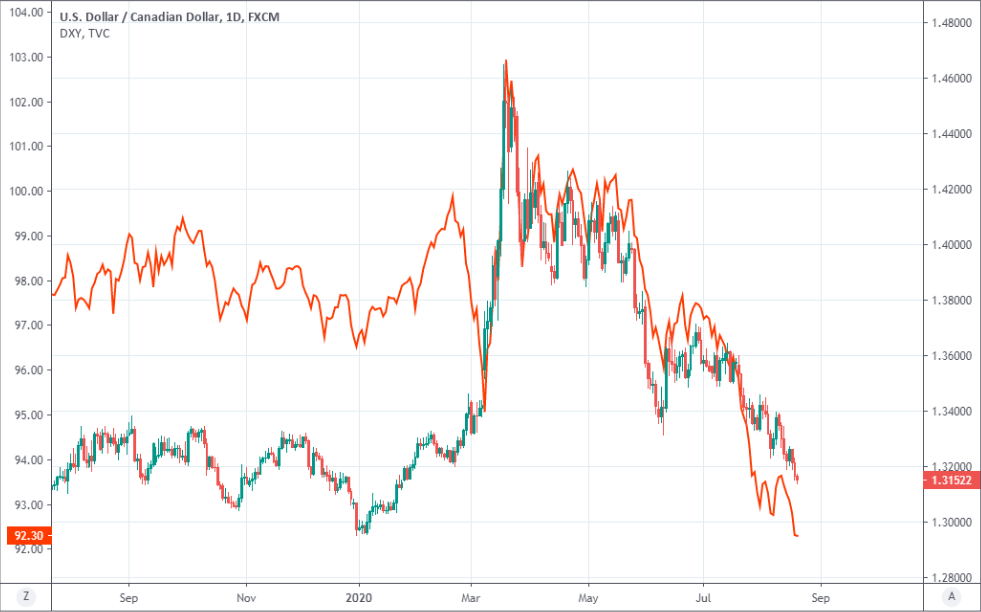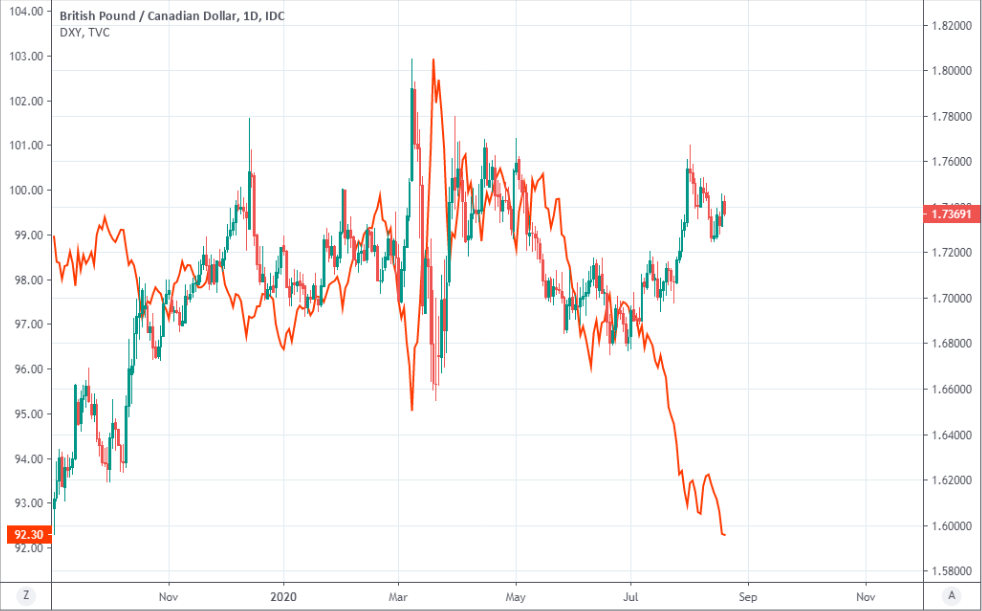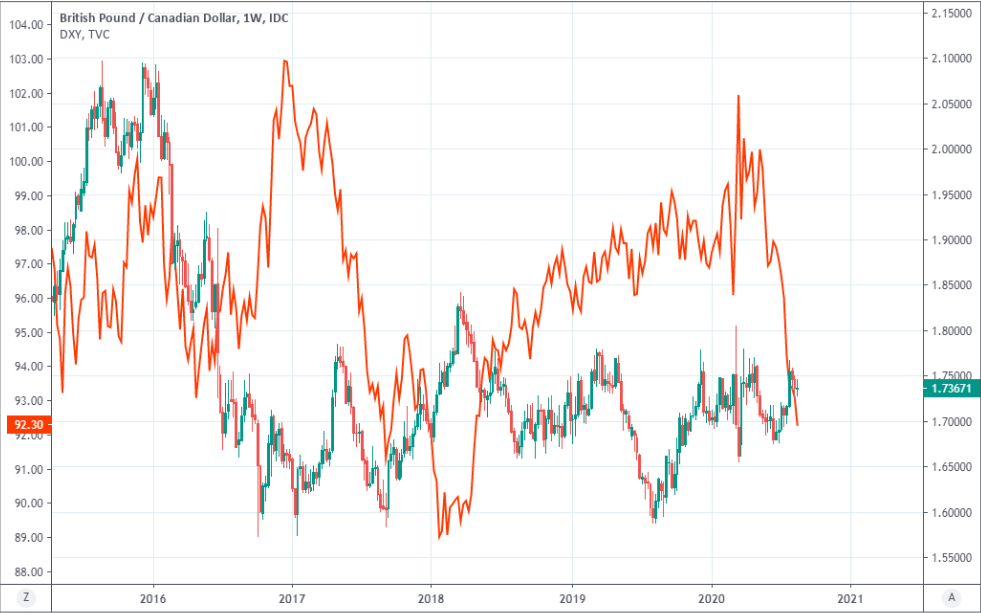Canadian Dollar Keeps Pressure on Sterling as Oil and Greenback Correlations Point the Loonie Higher
- Written by: James Skinner
-

Image © Adobe Images
- GBP/CAD spot rate at time of writing: 1.7373
- Bank transfer rate (indicative guide): 1.6753-1.6875
- FX specialist providers (indicative guide): 1.7112-1.7217
- More information on FX specialist rates here
The Canadian Dollar advanced on Sterling Wednesday as risky currencies consolidated gains following another Dollar Index breakdown, with the Loonie benefiting from correlations with the greenback, stocks and oil.
Canada's Dollar was higher against all other than the Kiwi and Australian Dollars on Wednesday as the U.S. Dollar Index steadied near to its lowest level since April 30, 2018 following moves that pulled USD/CAD lower while keeping pressure on the Pound-to-Canadian Dollar rate.
"We can see evidence that the correlation with the price of oil has strengthened. In a bullish technical development, the price of WTI closed above its’ 200-day moving average for the first time since 21st January 2020. The CAD is displaying the strongest relative bullish momentum amongst G10 currencies which will keep downward pressure on USD/CAD as it moves closer to 1.3000," says Lee Hardman, a currency analyst at MUFG in a recent research note.

Above: USD/CAD shown at daily intervals alongside Dollar Index (orange line, left axis).
Multiple narratives seek to explain currency market price action but whether it's negative inflation-adjusted bond yields, the supposed death of U.S. Dollar reserve status, a Eurozone outperformance of the U.S. or a simplistic "risk-on, risk-off" market, no narrative has gone completely uncontradicted.
However, and crucially for the Loonie, Canada's Dollar has benefited from a number of clear market trends that are favourable to it. The Dollar Index downtrend has endured and USD/CAD has a good positive correlation with it, while stock markets and oil prices have also been creeping steadily higher. The Canadian currency is correlatd with those too. Each of these are indicative of robust investor risk appetite.
"CAD is a leader in the risk rally in G10 and likely benefiting from some unwinding of its excessive short positions. The key condition for this dynamic to persist is the continuation of resilience in the oil market which is providing substantial support to the loonie. The lower exposure to China and trade tensions continues to suggest CAD may be a favourable option than antipodeans within the $-bloc space if risk sentiment remains bid," says Francesco Pesole, a strategist at ING.

Above: GBP/CAD rate at daily intervals. Shows changing relationship with Dollar Index (orange line, left axis).
The rub for the Pound-to-Canadian Dollar rate is that the entire time USD/CAD remains southbound, GBP/USD has to work harder to prevent GBP/CAD from falling. Sterling wasn't doing that very well on Wednesday.
GBP/USD was -0.21% lower at 1.3223 ahead of the North American open which, although still near to pre-March highs seen in the prior session, was enough to weigh on GBP/CAD amid strength in the Looonie. GBP/CAD is derived from USD/CAD and GBP/USD.
"Although the GBP has slipped back over the past two weeks (and has started off this week with a dip), weakness has been confined to within the range of the strong GBP up week from late July. This has the looks of a steep and somewhat extended consolidation which has started to steady around 1.7245," says Juan Manuel Herrera, a strategist at Scotiabank. "The GBP looks to have found good support at 1.7245 via a bullish “morning star” signal on the daily candle chart but we think a move above 1.7375 (minor trend channel, possible bull flag) is needed to lift the cross from here."

Above: GBP/CAD rate at weekly intervals. Shows changing relationship with Dollar Index (orange line, left axis).
GBP/CAD rose from below 1.72 to near 1.77 in little more than a week during late July but has since unwound close to all of that gain during August in what Scotiabank sees as an extended consolidation. Sterling struggled Wednesday to get back above 1.7375 as markets awaited Canadian inflation data.
This week's economic calendar comes alive from Wednesday onward when inflation data are released in Canada at 13:30, where investors are looking for the annualised average of three Bank of Canada measures of inflation to edge higher while the month-on-month reading of the consumer price index dips from 0.8% in June to 0.4% for July. The data is out before minutes of the July Federal Reserve meeting this evening and Canadian retail sales on Friday.
"Any upside surprise would be irrelevant to the Bank of Canada, as it would be viewed as unsustainable in the face of material economic slack," says Avery Shenfeld, chief economist at CIBC Capital Markets, of Canada's inflation number. "As was the case in the US, Canada likely saw a another big step forward in retail sales in June, but as is true stateside, it’s in discretionary services that aren’t in these data (concert halls, hotel rooms, airline tickets) where there’s still major damage."









